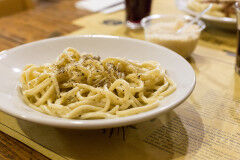Sift flours on a working surface, and form into a mound. Make a well in the center. Break in eggs, add a pinch of salt, and beat lightly with a fork; gently draw in the flour without allowing eggs to escape. Once eggs blended with flour and no liquid remains, start to knead the dough, until soft and elastic, and isn't sticky any longer. Work with clean hands (brush off any dry bits of flour) and eventually dust hands with more semolina to avoid sticking. After about ten minutes, once the dough is smooth and silky, wrap in plastic wrap or in a cloth and let rest for 20 minutes.
After the dough has rested, you can roll it with a rolling pin or with a pasta machine. Divide the ball in 2-3 pieces; keeping the pieces not currently being worked with covered (to avoid the dough from drying out). If using a rolling pin, roll the dough out on a floured board to reach 1-2 mm thickness. Work from the center out, until you have an even surface. Regardless of the rolling method, it's important to work the dough well, rolling and stretching to desired thickness.
If using a machine, pass at first through the thickest setting, 2-3 times, folding the dough over itself. Keep moving on to next settings, rolling the dough through each of them until the second thinnest setting, in order to have thin sheets of dough. Cut stretched dough into strips, either using the pasta machine cutter or by hand.
There are two different methods available for shaping ravioli with this filling:
1. make long stripes, about 10 cm large, and lay on a floured board. Place small mounds of filling evenly spaced apart (about 3 cm) all along the stripe; then cover with another pasta stripe and press with your fingers all around the filling. This will push the air out and seal the pasta. Generally it must be done quickly, otherwise fresh pasta dries out, and it becomes hard to close ravioli (if needed, you can brush the sides of the stripe with a little egg wash made from 1 egg white). Cut ravioli out with a roller cutter, leaving about 1-2 cm of pasta around the filling.
2. Alternatively, you can make larger stripes, place the filling on the longer side closer to you and fold the dough over onto the filling. Then proceed as above to shape and cut ravioli.
Using a round cookie cutter (8-9 cm) to cut pasta circles, spoon a heaping teaspoon of the filling onto the bottom part of each circle of dough (slightly off the center). Fold each circle over in half; then pinch the edges together with a fork to seal ravioli.
Arrange ravioli on a tray as the shapes are formed, sprinkle with some semolina, without overlapping them, until you have used all of the dough.

 Ingredienti
Ingredienti

 ....assolutamente da provare!
....assolutamente da provare!




